10 Easy to Grow Flowers From Seeds for Beginning Gardeners
- Sunflowers – These cheerful giants are perfect for beginners because they germinate quickly and grow rapidly. Simply plant seeds 1 inch deep after the last frost, and you’ll have towering blooms within 70-100 days. Sunflowers track the sun throughout the day, adding ever-changing movement to your garden.
- Marigolds – These pest-repelling flowers are incredibly forgiving for novice gardeners. Sow seeds directly in the garden after danger of frost has passed, and you’ll enjoy vibrant orange and yellow blooms all summer long. Marigolds thrive in both containers and garden beds with minimal attention.
- Zinnias – Among the easiest annual flowers to grow from seed, zinnias offer exceptional heat and drought tolerance. Plant seeds ¼ inch deep in well-drained soil, and within 60-70 days, you’ll have colorful blooms that attract butterflies and make excellent cut flowers for arrangements.
- Cosmos – These delicate-looking flowers are surprisingly tough and low-maintenance. Scatter seeds in a sunny spot after the last frost, and with little more than occasional watering, you’ll be rewarded with feathery foliage and daisy-like blooms that continue until fall.
- Nasturtiums – Both the flowers and leaves of nasturtiums are edible, making them practical additions to your garden. Plant the large seeds 1 inch deep in average soil (they actually prefer poor soil!), and within 35-52 days, you’ll have bright blooms in shades of red, orange, and yellow.
- Sweet Alyssum – This low-growing flower creates a fragrant carpet of tiny blooms. Simply press seeds into moist soil without covering them, and within 6-8 weeks, you’ll have honey-scented flowers that attract beneficial insects and spill beautifully over container edges.
- California Poppies – These drought-tolerant wildflowers require almost no care once established. Scatter seeds in a sunny location with well-drained soil, and within 55-75 days, you’ll enjoy vibrant orange-gold blooms that close at night and reopen each morning.
- Bachelor’s Buttons – Also known as cornflowers, these hardy annuals grow in almost any soil. Sow seeds directly in the garden in early spring, and you’ll soon have distinctive blue blooms (also available in pink and white) that make excellent dried flowers.
- Morning Glories – These fast-growing vines produce trumpet-shaped flowers that open with the morning sun. Nick the hard seeds and soak overnight before planting ½ inch deep near a trellis or fence, and within 10 weeks, you’ll have heart-shaped leaves and colorful blooms climbing up to 10 feet.
- Four O’Clocks – These old-fashioned favorites bloom in late afternoon (hence their name). Plant the black seeds 1 inch deep after all danger of frost has passed, and you’ll enjoy fragrant, trumpet-shaped flowers in multiple colors throughout summer and fall, often reseeding themselves for years to come.
Understanding the Basics of Growing Flowers From Seeds

Now that you’re familiar with the easiest flowers to grow from seeds, it’s important to understand the fundamental principles that will set you up for success. Growing flowers from seeds isn’t complicated once you grasp the basics of proper supplies and timing.
Essential Supplies for Seed Starting Success
To start your flower seeds successfully, you’ll need just a few basic supplies. First, gather containers with drainage holes—these can be specialized seed trays, recycled yogurt cups, or even egg cartons. Quality seed-starting mix is crucial as it’s lighter than garden soil and free from pathogens that could harm delicate seedlings. Bright light is essential, whether from a sunny south-facing window or fluorescent grow lights positioned 2-3 inches above your seedlings. Keep a spray bottle handy for gentle watering that won’t displace tiny seeds. For heat-loving varieties, consider a seedling heat mat to maintain optimal soil temperature. Finally, don’t forget plant labels to keep track of what you’ve planted—popsicle sticks or plastic markers work perfectly. With these simple supplies, you’ll be well-equipped to start your flower seed journey.
Best Times to Plant Flower Seeds
Timing is everything when growing flowers from seeds. For most annual flowers, start seeds indoors 6-8 weeks before your region’s last frost date to give them a head start. Cold-hardy annuals like sweet alyssum and calendula can be directly sown outdoors 2-4 weeks before the last frost. Summer bloomers such as zinnias and sunflowers perform best when sown directly after all danger of frost has passed and soil temperatures reach at least 60°F. For perennials, fall sowing works wonderfully—many require cold stratification (exposure to winter conditions) to break seed dormancy. Check seed packets for exact timing recommendations as requirements vary by species. By aligning your planting schedule with these natural rhythms, you’ll maximize germination rates and growing success.
Marigolds: The Perfect Starter Flower for Any Garden
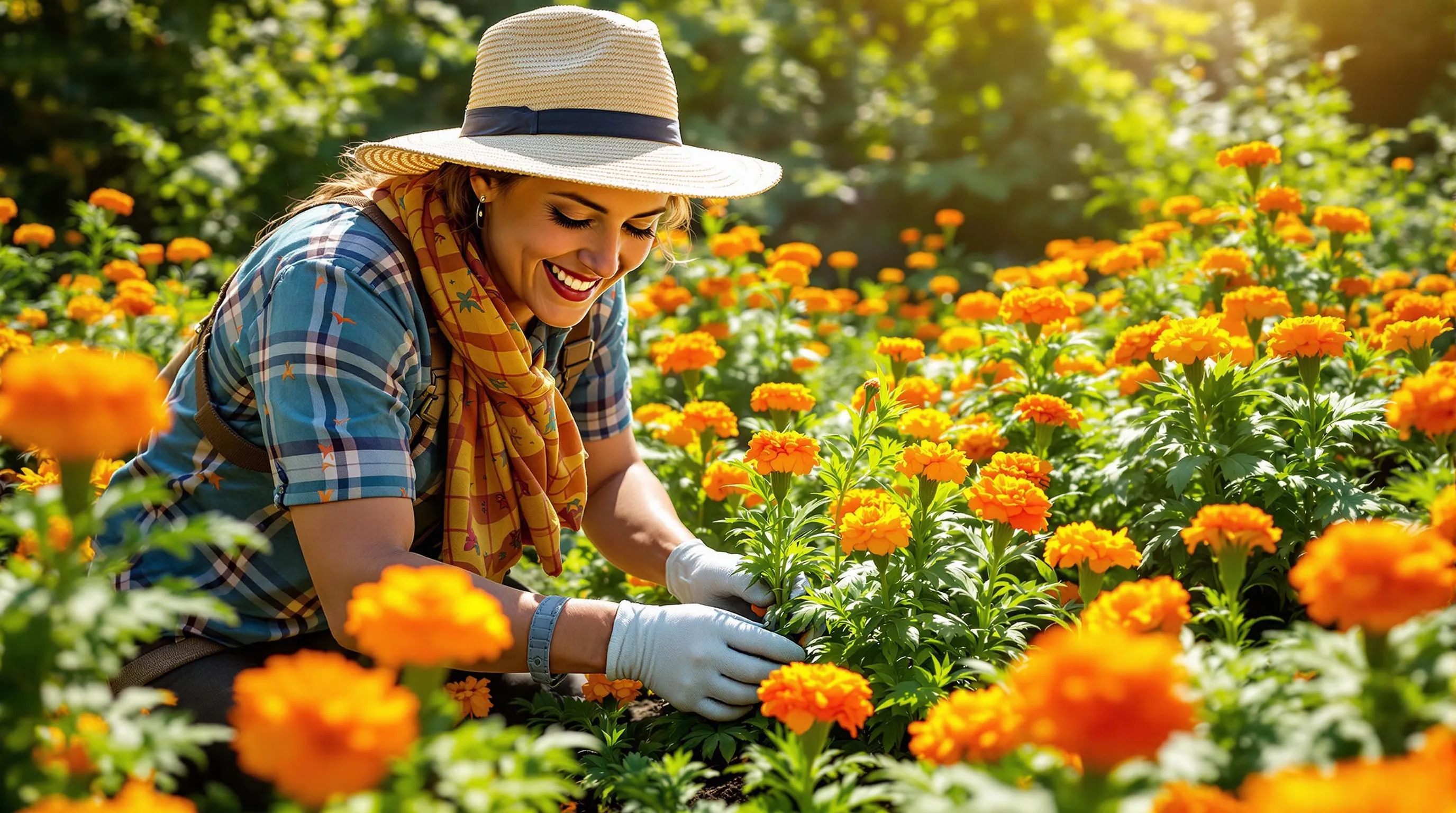
Marigolds top the list of beginner-friendly flowers for good reason. With their bright orange and yellow blooms and impressive resilience, these colorful annuals deliver maximum impact with minimal effort.
Growing and Care Tips for Marigolds
Starting marigolds from seed couldn’t be easier. Sow seeds directly in your garden after the last frost when soil temperatures reach 65°F. Press seeds lightly into the soil about 1 inch apart and cover with ¼ inch of soil. You’ll see germination within 5-7 days in warm conditions. For an earlier start, begin seeds indoors 4-6 weeks before your last frost date in seed-starting trays.
Marigolds thrive in full sun locations with at least 6-8 hours of direct sunlight daily. They adapt to most soil types but prefer well-draining soil with moderate fertility. Avoid overwatering—marigolds are drought-tolerant once established and actually bloom more profusely in slightly dry conditions. A light application of all-purpose fertilizer when planting provides enough nutrition for the season.
For bushier plants with more blooms, pinch back young seedlings when they reach 6-8 inches tall. Deadhead spent flowers regularly to encourage continuous blooming throughout summer and fall. Marigolds rarely face serious disease issues, and their natural pest-repelling properties help protect neighboring plants from harmful insects.
Creative Uses for Marigold Blooms
Marigolds offer more than just garden beauty. Their edible flowers add a spicy, citrusy flavor to salads and can be used as a saffron substitute in rice dishes. Harvest blooms in the morning when their essential oils are strongest.
Create natural dyes from marigold petals for fabrics and crafts—they produce lovely yellow to orange hues depending on mordant used. In cut flower arrangements, marigolds last 7-10 days and pair beautifully with zinnias and sunflowers for vibrant summer bouquets.
Many gardeners plant marigolds as companion plants near vegetables like tomatoes and peppers to deter nematodes and other pests. Their strong scent helps mask the chemical signals that attract harmful insects to your prized crops. Also, dried marigold petals make excellent additions to homemade potpourri mixtures, bringing their distinctive spicy scent indoors.
Zinnias: Vibrant, Heat-Loving Flowers That Thrive With Minimal Effort
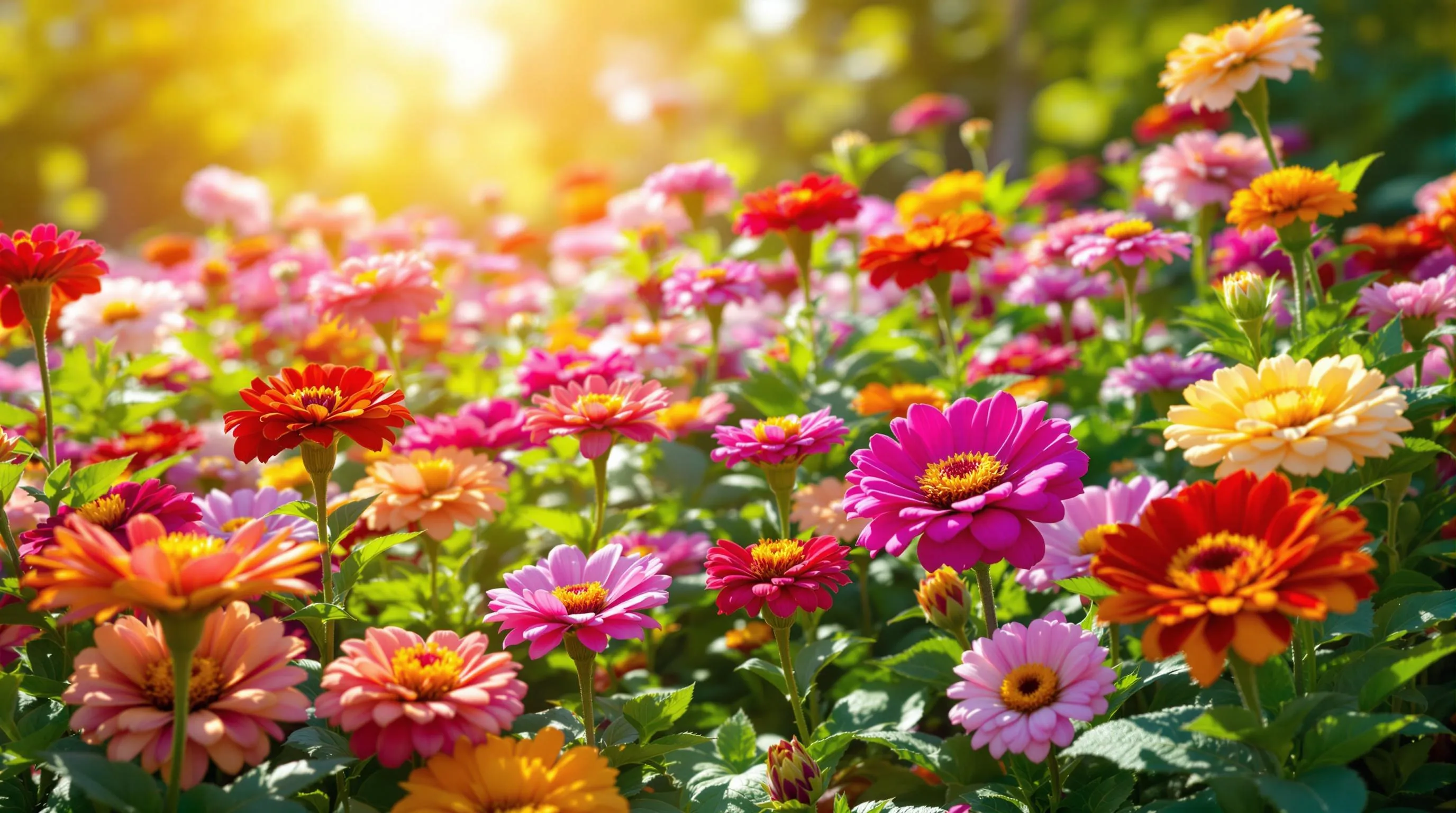
Zinnias rank among the easiest flowers to grow from seed, delivering exceptional value with their vibrant blooms and impressive heat tolerance. These Mexican natives germinate quickly (often within 4-7 days) and flourish in full sun and well-draining soil. You’ll enjoy continuous blooms from early summer until frost with minimal maintenance—simply sow seeds directly in your garden after the danger of frost has passed when soil temperatures reach 70°F.
Varieties of Zinnias for Different Garden Spaces
Zinnias come in an impressive range of sizes, colors, and forms to suit any garden space. For borders and containers, try compact varieties like ‘Thumbelina’ (6-8 inches tall) or ‘Profusion’ series (12-18 inches) that bloom prolifically without deadheading. Medium-sized options include the classic ‘California Giant’ (2-3 feet) and ‘State Fair’ mix with their 4-5 inch blooms in rainbow hues. For dramatic impact, plant ‘Benary’s Giant’ or ‘Queen Red Lime’ varieties that tower at 3-4 feet tall with dinner-plate sized flowers. Newer cultivars like ‘Queeny Lime Orange’ offer unique bicolor petals with extraordinary vase life, while ‘Zahara’ series provides exceptional disease resistance particularly against powdery mildew.
Harvesting Zinnias for Long-Lasting Cut Flowers
Harvest zinnias for arrangements during the coolest part of the day when blooms are fully open but still fresh. Cut stems at an angle with sharp scissors, selecting flowers with petals that stand upright rather than flat (indicating peak freshness). Remove all foliage that would sit below the waterline to prevent bacterial growth. For longest vase life, place cut zinnias immediately in water with floral preservative and change the water every 2-3 days. Strategic cutting actually stimulates more branching and additional blooms, so harvest frequently to maintain a productive garden. Most zinnia varieties last 7-10 days in arrangements, making them perfect for colorful bouquets throughout the growing season.
Sunflowers: Impressive Blooms With Simple Growing Requirements
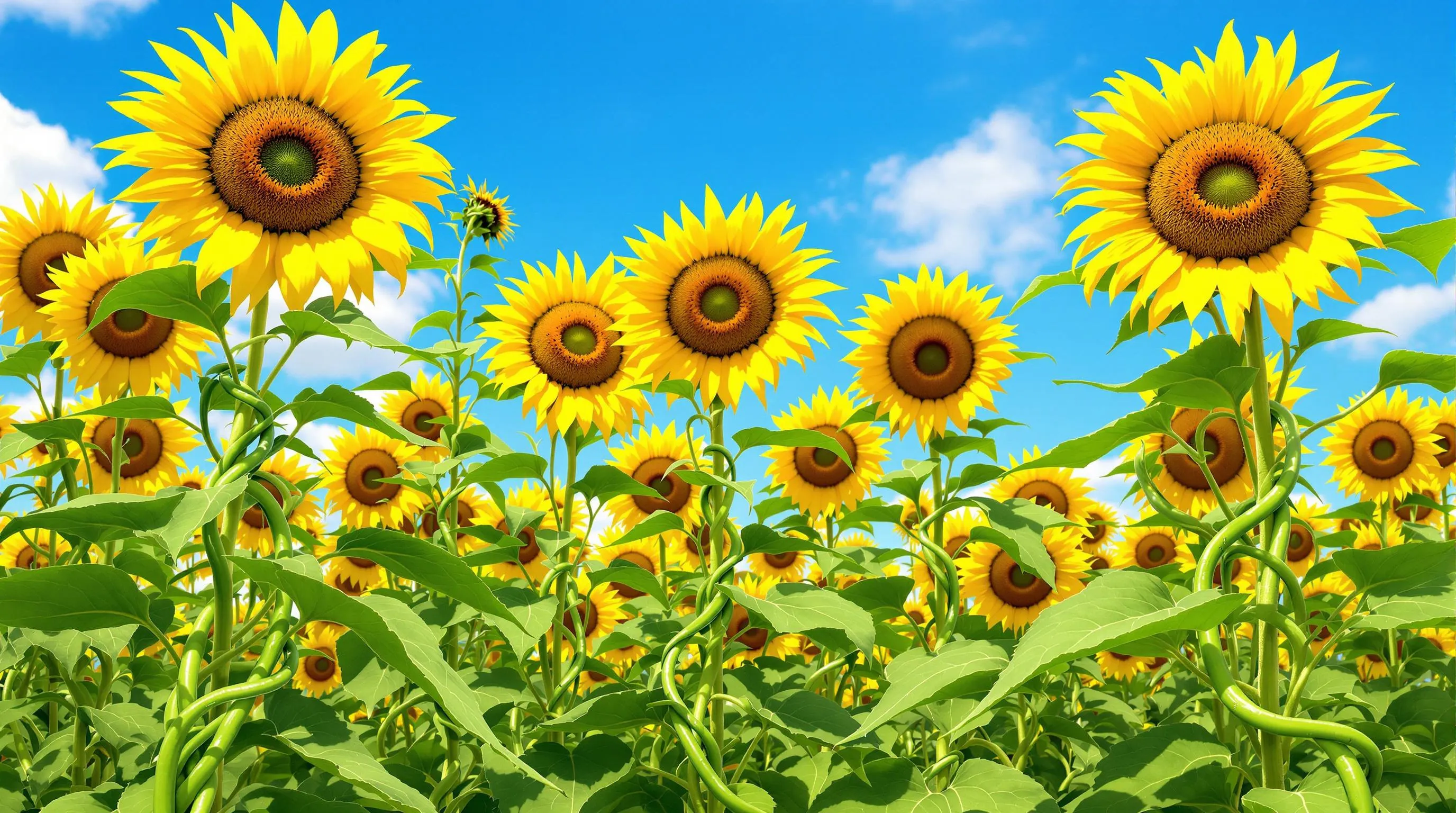
Sunflowers stand out as one of the easiest flowers to grow from seed, offering impressive blooms that can transform any garden space. These cheerful giants require minimal care while delivering maximum impact with their iconic yellow faces tracking the sun throughout the day.
From Seed to Towering Beauty: Sunflower Growth Timeline
Sunflowers boast one of the most rewarding growth timelines of any garden flower. You’ll see germination within 7-10 days when planted in warm soil (60-70°F). During weeks 2-4, seedlings establish strong roots and develop their first true leaves. By weeks 5-8, stalks rapidly elongate, sometimes growing several inches per day. Around weeks 9-10, flower buds form and begin to open. At 11-14 weeks, depending on variety, full blooms appear and can last for 2-3 weeks. Dwarf varieties mature faster (60-70 days), while mammoth types require 90-120 days to reach their impressive heights of 12+ feet. For continuous blooms, stagger your planting every 2-3 weeks from spring through early summer.
Using Sunflowers as Natural Garden Supports
Sunflowers serve as excellent natural supports in your garden. Plant them strategically to create living trellises for climbing vegetables like beans and peas, which naturally twine around the sturdy sunflower stalks. The thick stems of taller varieties can withstand important weight and weather conditions, eliminating the need for artificial supports. Also, sunflowers act as windbreaks for more delicate plants and provide partial shade for heat-sensitive crops during summer months. Their extensive root systems also help stabilize soil on slopes or in erosion-prone areas. For best results, plant support sunflowers about 12 inches apart in rows, allowing enough space for companion plants to grow alongside them.
Cosmos: Delicate Blooms That Flourish in Poor Soil Conditions

Cosmos flowers are among the most forgiving and adaptable seeds you can grow, thriving in conditions that many other flowers would struggle with. These daisy-like blooms actually prefer poor, well-draining soil and will often produce more flowers when not overfed. With their feathery foliage and colorful blooms ranging from white to pink, red, and orange, cosmos add an airy, cottage-garden feel to any space while requiring minimal maintenance.
Companion Planting With Cosmos
Cosmos make excellent companion plants in both vegetable and flower gardens. Their tall, sturdy stems create natural support structures for climbing plants like peas and beans while attracting beneficial pollinators to boost your garden’s productivity. Plant cosmos alongside tomatoes to deter tomato hornworms, or pair them with zucchini and squash to attract pollinators that increase your vegetable yields. Their open blooms attract ladybugs, lacewings, and hoverflies – natural predators that help control aphids, thrips, and other garden pests. For a stunning visual display, combine cosmos with shorter flowers like marigolds or zinnias to create a multi-layered effect that provides continuous color throughout the growing season.
Self-Seeding Benefits of Cosmos
Cosmos excel at self-seeding, making them a cost-effective choice for filling garden spaces year after year. Once established, these prolific bloomers drop seeds at the end of the growing season, which often germinate on their own the following spring. This natural reseeding habit means you’ll enjoy volunteer cosmos plants popping up in unexpected places, creating delightful surprises throughout your garden. To encourage self-seeding, simply leave some spent flowers on the plants at the end of the season instead of deadheading them all. You can also collect the distinctive long, thin seeds to control where next year’s plants will grow. For gardeners looking to maintain a more organized garden, simply pull unwanted seedlings as they appear – they’re easy to identify by their distinctive feathery foliage.
Nasturtiums: Edible Flowers That Grow Quickly From Seeds

Nasturtiums are among the most beginner-friendly flowers you can grow from seed, germinating within 7-10 days and blooming in just 35-40 days. Their vibrant orange, yellow, and red blooms add instant color to gardens while their peppery flavor makes them a dual-purpose plant for both ornamental and culinary uses. You’ll appreciate their ability to thrive in poor soil—in fact, they produce more flowers in less fertile conditions.
Culinary Uses for Nasturtium Flowers and Leaves
Nasturtiums offer your kitchen a peppery punch similar to arugula but with a colorful twist. The entire plant is edible—add the bright flowers to salads for a visual and flavorful boost, or chop the round leaves into sandwiches and wraps for a peppery kick. You can stuff the flowers with soft cheese for elegant appetizers or pickle the immature seed pods as a homemade substitute for capers. The flowers also make stunning garnishes for cakes and cocktails, maintaining their vibrant color even after being picked. For maximum flavor, harvest nasturtium flowers in the morning when their taste is most pronounced and use them immediately for the freshest culinary experience.
Container Growing Tips for Nasturtiums
Nasturtiums thrive in containers, making them perfect for patios, balconies, and window boxes. Choose containers at least 12 inches deep with drainage holes, as nasturtiums develop long taproots. Sow seeds directly in the container ½ inch deep and 10-12 inches apart, as transplanting can stunt their growth. Use well-draining potting mix without added fertilizer—too much nitrogen promotes lush foliage but fewer blooms. Position your containers in full sun to partial shade and water when the top inch of soil feels dry. For cascading varieties like ‘Jewel Mix’ or ‘Alaska,’ select hanging baskets or tall containers that allow their 2-3 foot trailing stems to spill over dramatically. Regular deadheading encourages continuous flowering throughout the growing season.
Sweet Peas: Fragrant Climbers That Bloom Abundantly From Seeds
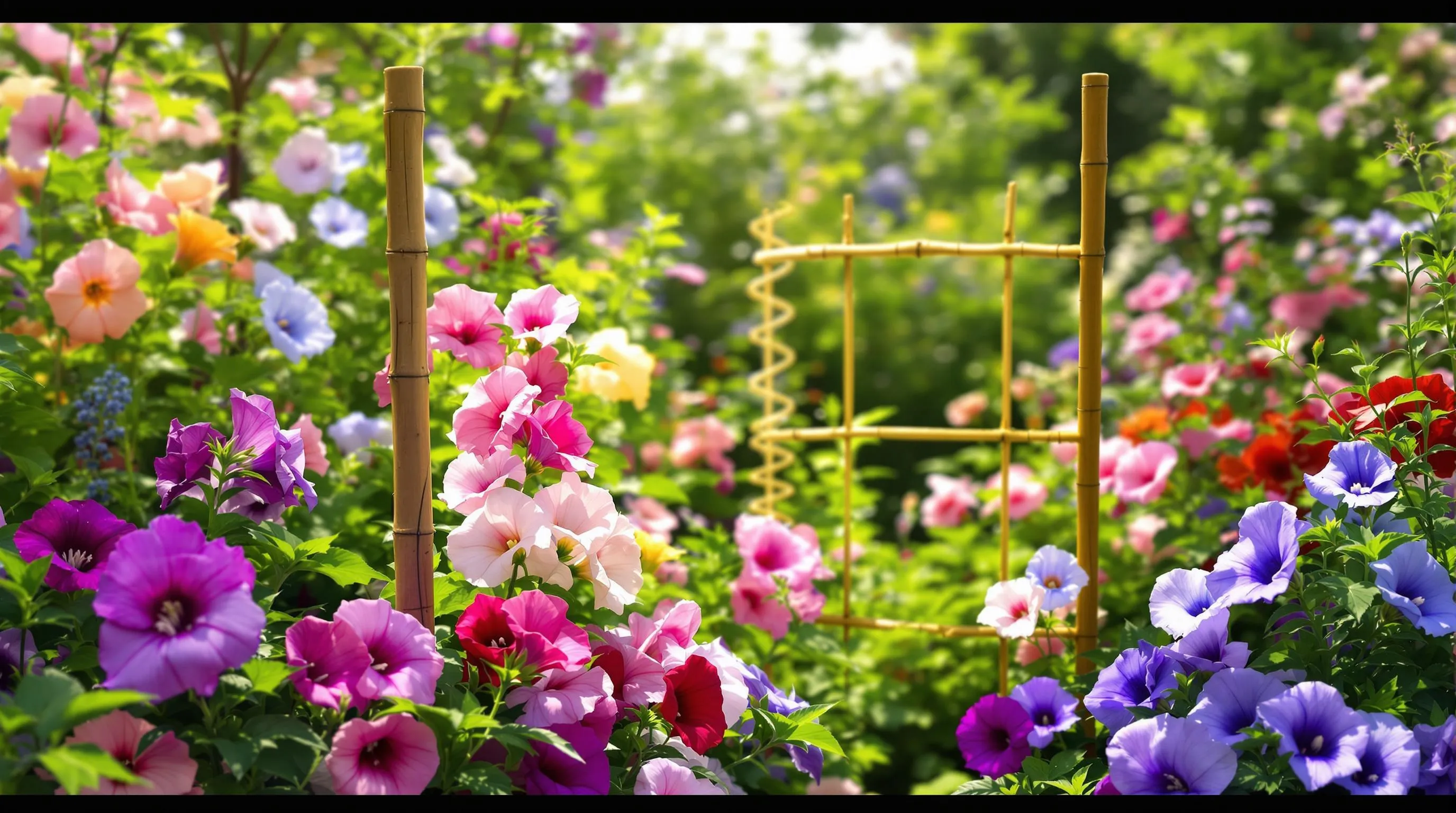
Sweet peas are delightful climbing flowers that produce masses of beautifully scented blooms in a rainbow of colors. These cottage garden favorites are remarkably easy to grow from seed and reward gardeners with weeks of fragrant flowers perfect for cutting. With their tendrils that naturally climb, sweet peas make excellent vertical garden elements while requiring minimal space.
Trellising Techniques for Sweet Peas
Sweet peas need proper support to reach their full potential of 6-8 feet in height. Create a simple trellis using bamboo poles arranged in a teepee formation, securing them at the top with twine for stability. Chicken wire attached to a fence or wall provides an excellent climbing surface that allows tendrils to grip easily. For a more decorative approach, try a repurposed ladder placed against a wall or an obelisk structure centered in a garden bed. Start training your sweet peas early by gently guiding young shoots toward their support, as they’ll quickly take hold and climb naturally. For container gardens, use a decorative spiral stake or fan-shaped trellis to keep the vines upright without overwhelming the pot.
Extending the Blooming Season of Sweet Peas
To enjoy sweet peas for months rather than weeks, carry out successive planting by sowing seeds every 2-3 weeks from early spring through early summer. Remove spent flowers promptly through regular deadheading, which prevents seed pod formation and encourages continued blooming. For cooler climates, choose heat-tolerant varieties like ‘April in Paris’ or ‘Windsor’ that will continue flowering even as temperatures rise. Apply a balanced liquid fertilizer every two weeks during the growing season to provide necessary nutrients for continuous bloom production. Morning watering at the base of plants keeps the soil consistently moist without wetting foliage, preventing mildew issues that can cut the flowering season short. In warmer regions, provide afternoon shade to protect plants from intense heat, extending their blooming period by several weeks.
Calendulas: Cold-Tolerant Flowers for Early and Late Season Color
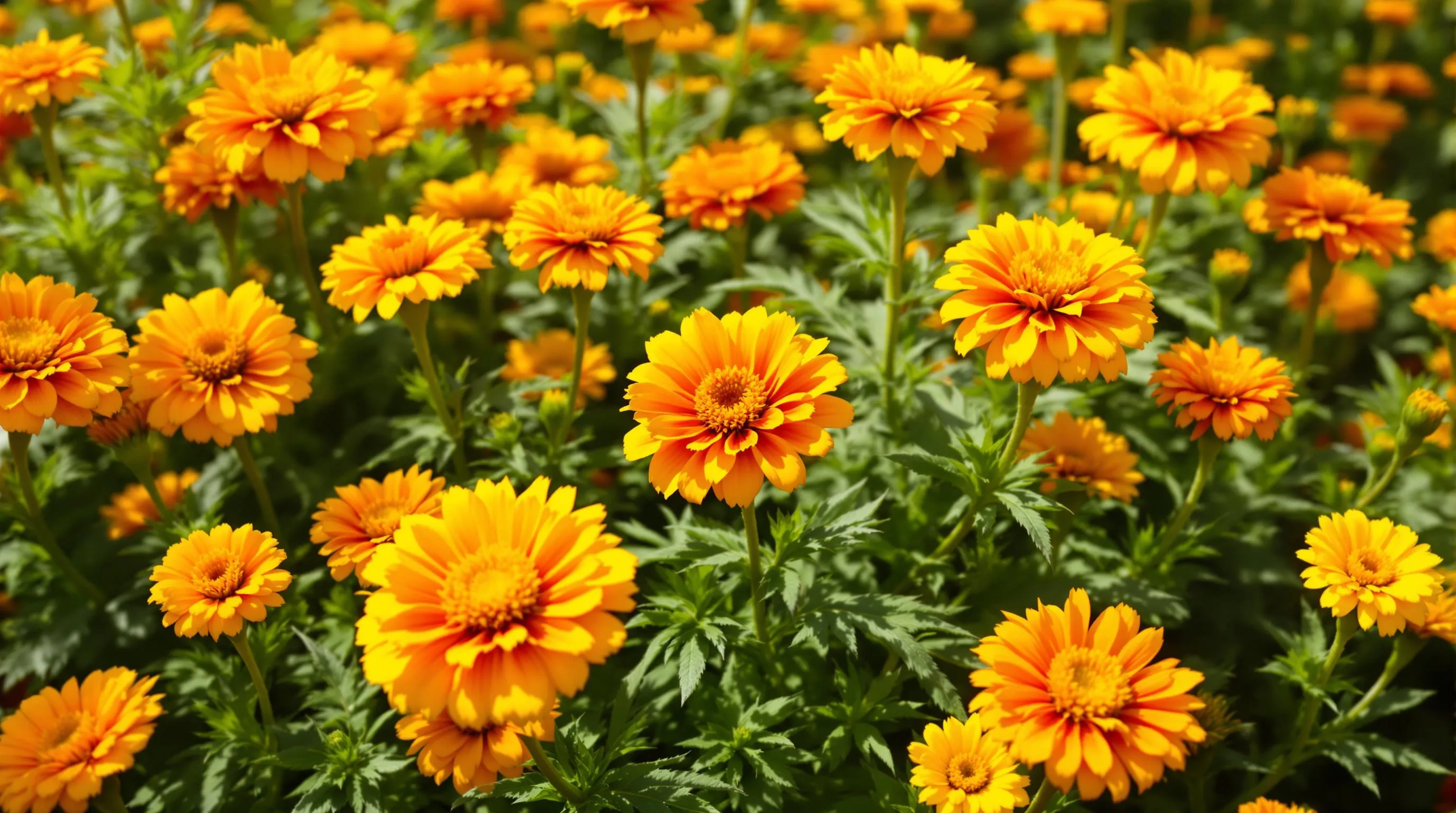
Calendulas (Calendula officinalis) are exceptionally easy flowers to grow from seeds, providing vibrant orange and yellow blooms that brighten gardens from early spring through late fall. These resilient annuals germinate in just 5-10 days and can withstand light frosts, making them perfect for extending your garden’s color season. Simply direct sow seeds 1/4 inch deep in moderately fertile soil once soil temperatures reach 60°F, or start them indoors 4-6 weeks before your last frost date for earlier blooms.
Medicinal and Skincare Uses of Calendula
Calendula flowers offer more than just ornamental value—they’re prized for their healing properties in both traditional and modern herbal medicine. The bright petals contain powerful anti-inflammatory and antimicrobial compounds that make them effective for treating minor skin irritations, burns, and wounds. To harness these benefits, harvest fully opened flowers on sunny mornings when their resin content peaks. Dry the petals thoroughly before using them to create healing salves, tinctures, or infused oils. Many commercial skincare products incorporate calendula extract for its gentle, soothing effects on sensitive skin. Creating your own calendula-infused oil is simple—fill a clean jar with dried petals, cover completely with olive or jojoba oil, and let it infuse for 4-6 weeks in a warm location before straining.
Pest-Repelling Properties of Calendula
Calendulas serve as excellent companion plants in vegetable gardens due to their natural pest-repelling abilities. Their strong scent deters aphids, whiteflies, and thrips while their sticky stems trap small insects that might otherwise damage your crops. Plant calendulas strategically around the perimeter of vegetable beds or intersperse them throughout your garden to create a natural pest management system. The bright flowers also attract beneficial insects like ladybugs, lacewings, and hoverflies that prey on garden pests. For maximum effectiveness, place calendula plants near susceptible crops like tomatoes, cabbage, and broccoli. Unlike marigolds, calendulas don’t repel soil nematodes, but their overall pest-deterrent properties make them valuable additions to any organic garden strategy.
Bachelor’s Buttons: Drought-Resistant Blooms for Beginners
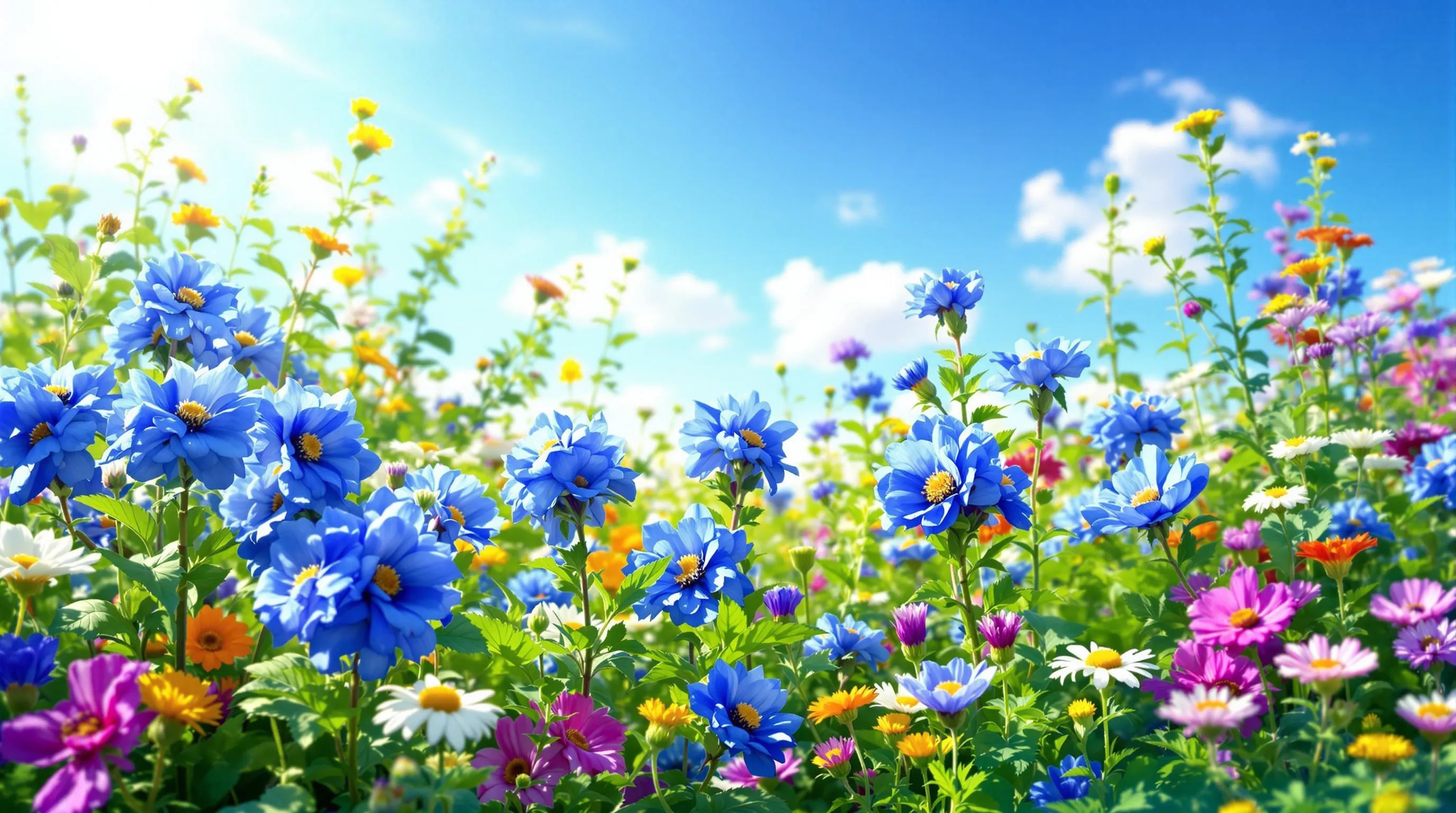
Bachelor’s buttons (Centaurea cyanus) are ideal starter flowers for novice gardeners due to their exceptional drought resistance and minimal care requirements. These charming blue blooms germinate quickly, often within 7-10 days, and thrive in poor soil conditions where other flowers might struggle. Simply scatter the seeds in a sunny spot after the last frost, lightly cover with soil, and water gently until established. Once growing, bachelor’s buttons require minimal attention, making them perfect for busy gardeners or those just developing their green thumb.
Creating Wildflower Meadows With Bachelor’s Buttons
Bachelor’s buttons excel as cornerstone plants in wildflower meadows, creating stunning natural displays with minimal effort. Scatter seeds in fall or early spring in a sunny location, mixing them with other wildflower varieties like cosmos, California poppies, and coreopsis for a diverse meadow effect. The blue hues of bachelor’s buttons provide a perfect contrast to yellows and oranges of companion flowers. For best results, prepare your meadow area by removing existing weeds and raking the soil lightly before broadcasting seeds at a rate of about 4 ounces per 1,000 square feet. The self-seeding nature of these hardy annuals ensures your wildflower patch returns year after year with increasingly established plantings.
Preserving Bachelor’s Buttons in Crafts and Arrangements
Bachelor’s buttons make excellent dried flowers, retaining their vibrant blue color long after harvesting. Cut stems when flowers are fully open but still fresh, gather them in small bundles, and hang upside down in a dark, dry area for 2-3 weeks. Once dried, these versatile blooms can be incorporated into wreaths, potpourri, or pressed flower art. For fresh arrangements, harvest in the morning when stems are hydrated and place immediately in water. Bachelor’s buttons typically last 5-7 days in vase arrangements and pair beautifully with complementary flowers like yellow coreopsis or white daisies. Their distinctive blue hue adds a pop of color to any display, making them a favorite for both rustic and formal flower arrangements.
Morning Glories: Fast-Growing Vines With Spectacular Blooms
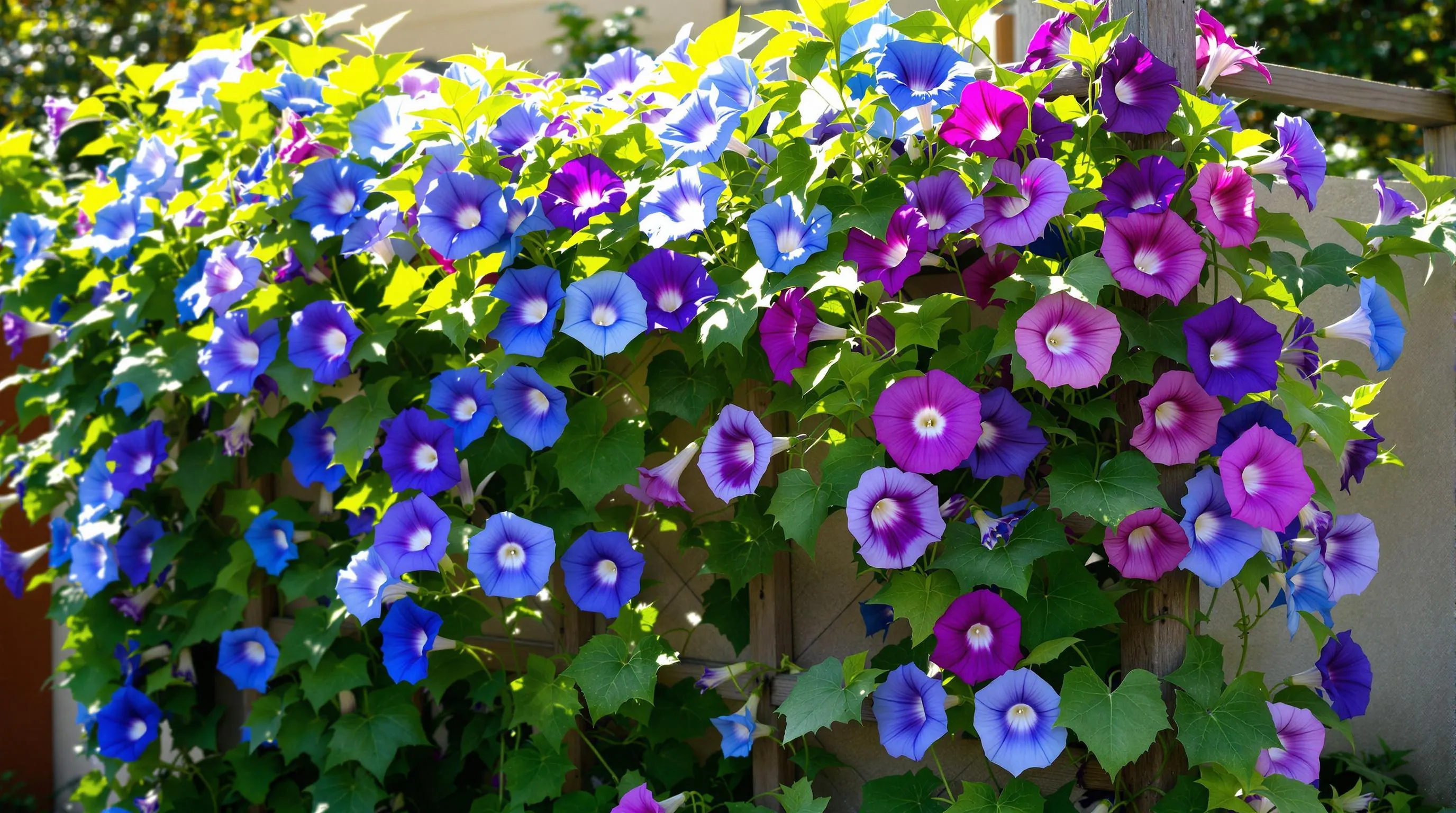
Morning glories rank among the most rewarding flowers to grow from seed, delighting gardeners with their trumpet-shaped blooms in vibrant shades of blue, purple, pink, and white. These vigorous climbers germinate within 7-10 days and can reach heights of 6-10 feet in a single growing season. Their rapid growth makes them perfect for quickly covering fences, trellises, or unsightly garden features while adding vertical interest to your industry.
Training Morning Glory Vines in Small Spaces
Morning glories thrive even in limited garden spaces when properly trained. Start by soaking seeds overnight to speed germination, then plant them in well-draining soil after all danger of frost has passed. For container growing, choose pots at least 12 inches deep with sturdy trellises. In small gardens, direct morning glories vertically using twine, fishing line, or mesh supports attached to walls or fences. Create beautiful living screens by training them on free-standing structures like obelisks or tepees. These adaptable vines will climb anything they can wrap their tendrils around, transforming balconies, patios, and tiny garden corners into flowering showcases.
Controlling Morning Glory’s Enthusiastic Growth
Morning glories grow with remarkable vigor that requires strategic management. Pinch back growing tips when vines reach desired heights to encourage bushier growth and more blooms. Remove spent flowers regularly to prevent self-seeding, as morning glories can become invasive in some regions. In colder climates, these annuals naturally die back after frost, but in warmer zones, consider growing them in contained areas or borders with barriers to prevent spreading. Harvest seed pods before they burst open if you want to control their spread while saving seeds for next season. With proper monitoring, you’ll enjoy these spectacular bloomers without letting them take over your garden.
Common Mistakes to Avoid When Growing Flowers From Seeds

Even the easiest flowers to grow can fail when common pitfalls aren’t avoided. Overwatering seeds is perhaps the most frequent mistake, causing them to rot before they germinate. Many gardeners also plant seeds too deeply—most flower seeds need only a light covering of soil or even direct contact with sunlight to sprout. Starting seeds too early indoors can result in leggy, weak seedlings, while improper hardening off can shock young plants when moved outdoors. Using regular garden soil instead of seed-starting mix creates poor drainage and may harbor diseases. Ignoring seed packet instructions about spacing and light requirements leads to overcrowded, competing plants. Forgetting to label your seeds can cause confusion when similar seedlings emerge. Finally, inconsistent watering—either too much or too little—stresses young plants and inhibits proper development. By avoiding these common errors, you’ll dramatically increase your success rate with growing flowers from seeds.
Conclusion: Building Confidence Through Easy-to-Grow Flower Seeds
Growing flowers from seeds isn’t just economical—it’s the gateway to a more diverse and rewarding garden. With minimal supplies and attention to timing you’ll be amazed at how quickly those tiny seeds transform into stunning blooms.
Whether you start with resilient marigolds fuss-free zinnias or towering sunflowers these beginner-friendly varieties will help build your gardening confidence. Each success prepares you for more ambitious projects.
Remember that mistakes are part of the learning process. By avoiding common pitfalls and following the exact needs of each variety you’ll soon develop an instinct for what works in your unique growing environment.
So grab those seed packets and get started! Your garden—and your gardening skills—will flourish with each seed you plant.





